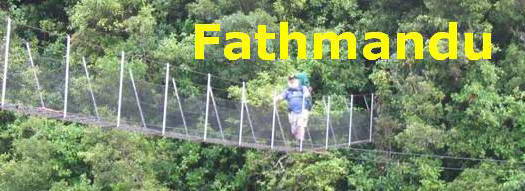
Many thanks for permission to use graphics from their software and toposheets |
 |
|
Karekare-Pararaha p.2
The track down the valley is about 400mm wide and often nearly the same deep, and passes through a variety of bush and scrub, both windblown, along open ground and by the edge of the swamp.
The valley funnels the often fierce prevailing westerly winds and most of the plants take a beating. Foreground left you see a small patch of gorse, and along with blackberry and thistle these weeds need constant efforts to control. (I think I was in favour, though, of a small cape gooseberry plant that found a home near the shelter.)
A boardwalk takes us through the swamp but the rising water level leaves even that submerged at times. Several small stream crossings provide a minor challenge to dry boots, and they would need serious wading in winter, I imagine.
The manuka and kanuka that used to thrive here when the land was dry have long succumbed.
There are still patches of relatively dry land, and the odd ancient fencepost, still featuring a few staples and a scrap of #8 wire. The cabbage trees in this valley have been especially badly affected by the virus that for a time threatened to exterminate the species in New Zealand. Fortunately a few resistant variants have appeared and the population nationally seems to be on the increase again.
We move on out toward the big dune at the mouth of the valley
The soft sand on the big dune brings me back to a reality I had elected to forget in the previous hour or so. The sun is high, the sand is baking and sends its heat up into my face, and I swallow water almost as regularly as I stop for a breathtaking photograph.
Unlike the water further up the valley, the local stuff is not drinkable. DOC has been here before us. Fortunately, I have humped in a considerable amount of water as makeweight.
|
|